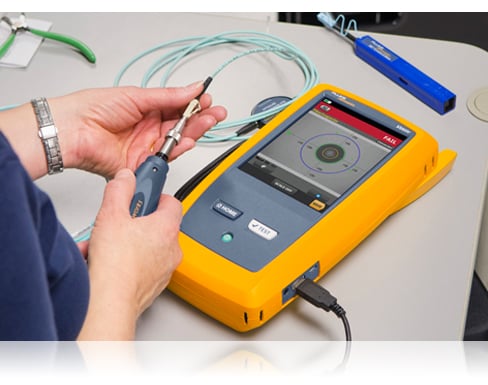Top 5 reasons to implement robotic vision in your assembly process
All You Required to Find Out About Robotic Vision and Its Applications in Advanced Optical Measurement Solutions
Robotic vision stands for a significant improvement in the intersection of computer vision, fabricated intelligence, and artificial intelligence. This innovation boosts the precision of optical measurement systems, enabling real-time data analysis and improved quality assurance. Its influence spans numerous fields, from manufacturing to health care. Nonetheless, the developing landscape of robotic vision elevates inquiries regarding future abilities and applications (optical fibre diameter analyser). What advancements lie ahead in this transformative field?
Understanding Robotic Vision: Secret Concepts and Technologies
Robotic vision encompasses the modern technologies and approaches that allow machines to interpret and recognize aesthetic info from their atmosphere. This field incorporates aspects of computer vision, expert system, and maker discovering to help with automatic decision-making based upon visual data. Trick ideas include picture processing, which includes the improvement and evaluation of images to remove purposeful functions, and item recognition, which enables devices to determine and categorize items within a scene.

The Combination of Robotic Vision With Optical Measurement Systems
As industries progressively demand accuracy and efficiency, the combination of robot vision with optical dimension systems has actually emerged as a transformative approach. This harmony permits robotics to view and interpret their surroundings, improving the capability of optical dimension systems to examine and examine things with unparalleled accuracy. By gearing up optical sensors with advanced imaging innovations, robot vision enables real-time data collection and handling, helping with instant adjustments to measurement specifications.
Additionally, the mix equips automated systems to identify variants in measurements, surface area quality, and positioning, which are essential in top quality control procedures. Improved formulas, such as device knowing, further boost this combination by improving the systems' ability to adjust to various environments and scenarios. Consequently, the combination not just enhances measurement procedures yet also reduces errors, guaranteeing that products satisfy stringent market requirements, therefore strengthening the duty of robot vision in the future of optical measurement systems.
Applications of Robotic Vision in Manufacturing
In contemporary manufacturing settings, using vision systems has actually changed production processes by enabling makers to perform jobs with amazing accuracy and rate. Robotic vision systems are significantly employed for quality assurance, where they inspect items for flaws and warranty adherence to specifications. These systems make use of cams and advanced algorithms to analyze products in real-time, significantly minimizing the threat of human mistake.
Furthermore, robot vision promotes automation in production line, permitting robotics to accurately determine parts and construct them with marginal downtime. This modern technology also enhances stock monitoring, as vision systems can keep an eye on stock levels and detect inconsistencies, assuring a seamless supply chain.
Furthermore, robot vision aids in the application of wise manufacturing facilities, where information from vision systems can be incorporated with other innovations to maximize operations. In general, the applications of robotic vision in producing show its essential duty in enhancing efficiency, quality, and efficiency throughout numerous fields
Robotic Vision in Medical Care: Revolutionizing Patient Care

In rehab, robot vision aids in keeping track of individual development and tailoring treatment sessions to private needs. It sustains physician by automating jobs such as data collection and person tracking, enabling even more time to concentrate on direct individual communication. Furthermore, robot vision boosts telemedicine by making it possible for remote diagnosis and online consultations, linking the gap between individuals and health care service providers. On the whole, the application of robot vision in healthcare is reinventing person care, resulting in boosted outcomes, effectiveness, and individual satisfaction.
Future Trends and Advancements in Robotic Vision Innovation
The quick evolution of robot vision modern technology assures to further enhance its applications across different industries, consisting of medical care. Future fads show a substantial change in the direction of including expert system and artificial intelligence, enabling systems to learn from vast datasets and improve accuracy gradually. Boosted sensing unit modern technologies and deep discovering formulas are expected to refine object recognition abilities, enabling robots to interpret complex settings extra properly.

The integration of augmented fact (AR) with robotic vision will likely revolutionize just how robots assist in medical treatments and diagnostics. This synergy will certainly assist in real-time data visualization, boosting decision-making procedures. Additionally, miniaturization of components will certainly cause more portable and flexible robot vision systems appropriate for a variety optical measurement system of jobs. As these innovations unravel, sectors will certainly witness enhanced automation and performance, solidifying robot vision as a foundation of innovative technical services.
Regularly Asked Questions
What Are the Key Components of a Robot Vision System?
The main components of a robot vision system include electronic cameras for image capture, cpus for data analysis, formulas for interpretation, and actuators for movement. With each other, these elements make it possible for robots to perceive and engage with their atmosphere effectively.
Exactly How Does Robotic Vision Improve Precision in Measurements?
Robotic vision enhances dimension precision by utilizing advanced imaging modern technologies, enabling exact things detection and spatial analysis. This capacity reduces human error, enhances repeatability, and allows for real-time adjustments, eventually boosting overall measurement dependability and efficiency.
What Industries Advantage The Majority Of From Robotic Vision Modern Technology?
Numerous sectors profit greatly from robotic vision technology, including manufacturing, healthcare, agriculture, and logistics. These sectors utilize enhanced precision, efficiency, and automation, resulting in improved productivity and reduced functional prices in their corresponding processes.
Can Robotic Vision Equipments Operate In Low-Light Issues?
Robotic vision systems can undoubtedly work in low-light conditions, utilizing innovative sensing units and formulas to improve photo clarity. This capacity enables them to do effectively in numerous atmospheres, consisting of commercial and monitoring applications, despite having minimal illumination.
What Are the Expenses Connected With Executing Robotic Vision?
The costs related to carrying out robotic vision vary substantially, affected by components such as electronic cameras, software program, and integration. Added costs consist of maintenance, training personnel, and possible upgrades to existing systems, which can build up over time.